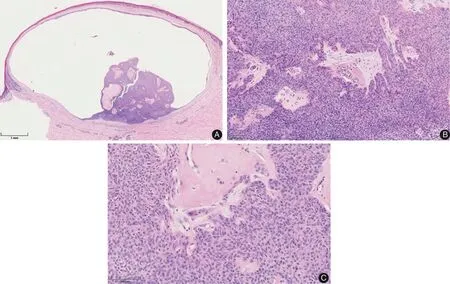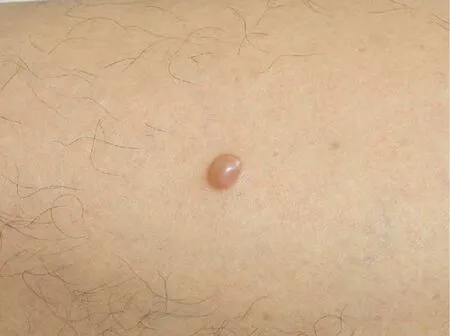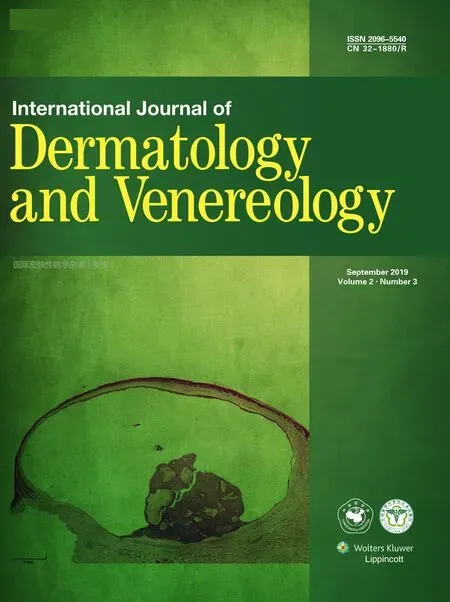Solid-Cystic Hidradenoma
Zi-Yuan Li and Jian-Min Chang∗
Department of Dermatology, Beijing Hospital, National Center of Gerontology, Beijing 100730, China.

Figure 1. Histopathological features of the lesion of solid-cystic hidradenoma. (A) The nodule is seen in the dermis. There were both a large cavity and a solid component in it(H&E stain,×40).(B)The cysts consist of uniformly eosinophilic materials(H&E stain,×100).(C)The tumor cells were characteristic of slightly basophilic cytoplasm and round nuclei (H&E stain, ×400).

Figure 2. The presentation of solid-cystic hidradenoma.1cm×1cm firm nodule on the left thigh with smooth surface.
Histopathology
Solid-cystic hidradenoma (SCH) is located in the dermis and can be attached to the epidermis or extend into the subcutaneous tissue.The lesion is well circumscribed with clear edge. It can be encapsulated or unencapsulated.There were both a large cavity and a solid component in the tumor.The cyst is lined by flattened or cubic secretory cells, while the cystic wall is more often constituted by tumor cells.Therefore,the cystic cavity may be caused by the necrosis of tumor cell. The cysts consist of uniformly eosinophilic materials.The tumor cells were characteristic of slightly basophilic cytoplasm and round nuclei. Most SCH have a duct-like structure, which consists of a monolayer of cubical cells with eosinophilic walls(Fig. 1A-1C). Tumor lobules are surrounded by collagen fibers, blood vessels, and other interstitium, which sometimes have transparent degeneration.1
The tumor cells express EMA and CEA,which suggests that SCH is a neoplasm of ductal differentiation.2
Clinical figures
SCH, also known as clear cell hidradenoma, nodular hidradenoma,or eccrine acrospiroma,is a rare benign skin adnexal tumor of sweat gland origin. The incidence of SCH in female is higher than in male. This disease may occur in any part of the body.It often occurs on the scalp,neck,and limbs.The tumor usually appears as an isolated solid or cystic nodules(Fig.2).It grows slowly,existing for several months or years. The surface of the tumor is smooth. About 15% of cases may lead to ulceration and drain serous secretion.3The subjective symptom of most cases is often absent. Sometimes SCH may be associated with hemorrhage, tenderness, itching, and burning. The diagnosis of this tumor mainly depends on histological and pathological examination.Some researchers have reported that skin ultrasound examination is also helpful for the diagnosis of SCH.4
Because the lesion is limited,surgical resection is usually used for the treatment of this disease. But if the surgery is incomplete, the tumor may recur. Extensive surgical excision is generally recommended, and the long-term follow-up is necessary.5
- 国际皮肤性病学杂志的其它文章
- Arteriosclerosis Obliterans Presenting as Multiple Leg Ulcers: A Case Report
- Interstitial Mycosis Fungoides with Systemic Sclerosis-Like Features: A Case Report
- Nasal Type Extranodal NK/T-Cell Lymphoma Presenting with Unilateral Facial Erythemas,Nodules, and Necrosis
- Lentigines within Nevus Depigmentosus
- Subungual Exostosis Misdiagnosed as Subungual Wart
- Severe Port Wine Stain with Significant Nodules and Alveolar Bone Invasion Leading to Restricted Mouth Opening

